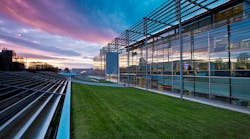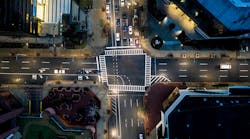West Nottingham Township, Pennsylvania hopes to reduce street light energy usage by 60% via new Relume Technologies outdoor LED-based luminaires installed by Stouch Lighting. Napa, California has installed 148 LED street lights hoping to save $12,000 per year in energy costs. But some utilities still don’t see solid-state lighting (SSL) as a mature technology and are blocking LED retrofits.
In West Nottingham, Stouch replaced 100W, 150W, 250W, and 400W high-pressure sodium (HPS) lights with a mix of 56W, 83W, and 250W LED luminaires. The retrofit also included the replacement of a 400W halogen flood light with a 120W SSL flood light at a park and ride lot.
Stouch asserts that the Relume products are providing brighter and more uniform lighting without light trespass or glare issues, and city officials agree.
"The lighting will improve the safety in our community as well as reduce energy consumption and energy costs through efficiency improvements; taking us one step forward to becoming more energy efficient while increasing productivity for economic growth and community development," said Candace Miller, Secretary/Treasurer for West Nottingham Township. "Exploring the value of LED lighting fixtures, getting the best solution, and achieving increased light output; is a tremendous benefit for our township and the community."
Stouch and the city are projecting a 60% reduction in energy usage. They didn’t project maintenance savings but the lights should deliver in that area as well. The installed luminaires are rated for 70,000 hours, and life expectancy is 15 years with no lamp or driver maintenance required. Moreover the fixtures are covered by a seven year warranty.
Napa uses EECBG funds
Napa, California received a $100,000 US DOE Energy Efficiency and Conservation Block Grant (EECBG) for a just completed SSL street light retrofit. The New Streetlights website reports that the city replaced 148 HPS lights with cobrahead SSL luminaires. The city projects $12,000 per year in energy savings.
Napa promotes itself as a green city, and in fact hosts its own CleanGreenNapa blog. According to that site, the city also recently installed LED lighting in the downtown Second Street Parking Garage and is planning SSL projects for a community center, a fire station, and a city maintenance yard. The city used Facebook to post before and after photos of a part of the street-light project on the Maxwell Bridge.
The trend toward LED street-light conversions is a strong one especially when you consider the available grant funding on top of energy and maintenance savings. Indeed conversions are happening across the US. Wellington, Ohio just installed 65W SSL fixtures replacing 150W HPS lights along state Routes 58 and 18 according to the local Chronicle-Telegram newspaper. A city official said that a federal grant enabled the project that will save enough energy to power two average houses.
New Streelights reported that Stevens Point, Wisconsin has completed a retrofit of 331 250W HPS lights with BetaLED SSL fixtures using grant money. The city has initiated another project to install 24 decorative post-top fixtures from Philips Hadco in its downtown area.
Western utilities stymie LED proponents
With the success cities are having in LED conversions, it’s a bit hard to understand why any utility would stand in the way of LED retrofits, but that is just what is happening in parts of Montana and other western states according to the Summit Daily News based in Frisco, Colorado. A column entitled Writers on the range: LEDs ought to be leading the way points out that NorthWestern Energy in Montana and Xcel Energy in Colorado won’t support LED lighting. NorthWestern has even gone so far as to go to court to block LED lighting projects, according to the article, claiming that LED lighting doesn’t have market acceptance.
The fact that a utility blocks the use of LED lighting can have a double impact on municipalities. Obviously, a city misses out on significant potential energy savings. But the city may also miss out on the chance to receive grant funds for energy-efficient lighting upgrades.




